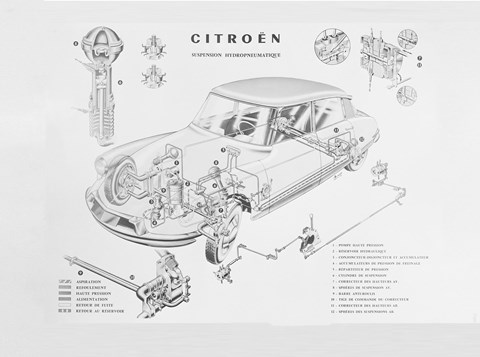► Hydropneumatic suspension RIP?
► Media reports suggest Citroen to drop it
► Soft nitrogen-riding chassis since the 1955 DS
It’s sounding ominously as though Peugeot Citroen (PSA)’s hydropneumatic suspension could be facing the axe, as new management scrutinises unnecessary costs.
News agency Reuters is quoting ‘several sources close to the company’ saying that the hydraulic suspension set-up will be phased out with the current C5. If accurate, it would spell the end for a curio technical solution which became closely associated with the French brand ever since the DS shook the luxury car scene with its serene magic-carpet ride quality in 1955.
It’s ironic that the news has leaked out, just as the company is celebrating the Déesse‘s diamond anniversary.
Peugeot and Citroen’s hydropneumatic suspension
French cars have had an on-off relationship with the chassis system over the years; today no products use hydropneumatics apart from the C5 and critics claim it has become expensive and off-the-pace in light of recent advances in regular steel springs and dampers, with computer assisted semi-active systems. And anyone who’s ever worked on a DS chassis will know that the system (outlined below in a period diagram) is devilishly complicated to maintain.
Citroen’s system uses an hydraulic pump and pneumatic spheres filled with nitrogen gas to provide bump absorption – a happy spin-off being self-levelling so efficient that cars can even be driven on three wheels without the ride height being affected. When properly tuned, the system is credited with a soothing ride detached from the patina of the road beneath the wheels.

Ironically, none of the current-day DS models use hydropneumatics – we berated the steel-sprung DS5 for this omission when we first drove it in 2011.
Why is PSA purportedly scrapping it now?
Because of poor sales and a belief that consumers no longer recognise its advantages. Automotive News Europe claims just 10,000 hydropneumatic Citroen C5s were sold in 2014. PSA officials have refused to comment on the rumours, but ANE quoted one source as blaming new CEO Carlos Tavares who’s on a cost-cutting mission to put the French company back on a path to profitability.
‘Tavares has made it clear that there are now other systems that can do just as well,’ said one industry source. ‘Hydropneumatics cost a lot for not much benefit.’